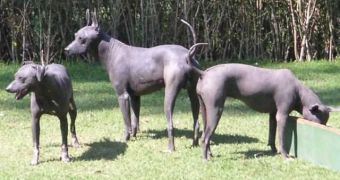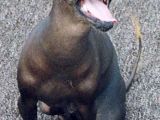What's the similarity between a whale, a worm and a Xoloitzcuintle?
They have no hair...
The body of this black dog breed is almost completely devoid of hair. Only the tip of the tail displays a white tuft of hair.
This dog looks like a Pharaoh Hound, with a sleek body, almond-shaped eyes, large bat-like ears, and a long antelope neck. Many individuals may also lack several teeth and the degree of hairlessness varies from individual to individual.
There is even a "coated" Xoloitzcuintle variant, with a very short coat of hair. Sometimes, Xoloitzcuintle can be pink, but this is an undesired trait.
Before the arrival of the Spaniards, these dogs were extremely appreciated pets in Mesomerica and they may be at least 3,500 years old.
Aztecs believed the Xolo dogs were needed by their masters' souls to help them go safely through the underworld, that why xoloitzcuintle were buried together with their owners. "Xolos" were regarded to also have a therapeutic value.
Indeed, the physical contact with this little companion was useful for rheumatism patients: a xolo can warm your feet on a chilly night... (the dog is as efficient as a boiling water pouch as its body has a temperature of 104 ?F/40 ?C.)
A more sinister aspect for the westerners is the use of this dog as meat source. In Aztec banquets, a large number of Xolos were sacrificed and even today many Mexican tribes consume its meat, which is also seen as medicinal.
A xolo can make the perfect pet: like many dog breeds, they can be trained and can have various sizes, from 50 pounds (20 kg) to a dwarf variety of 10 pounds (4 kg).
Their great advantage is the lack of hair, which means no fleas and an ideal choice for those allergic to dog hair, while their care is not difficult. To maintain a xolo's skin soft, this must be sloshed from time to time with a cream or a body oil.
And when bathed, the dog dries in just one or two minutes!...
Xolo has been on the danger of extinction, but great efforts have been made for its rescue, and now the dog can be found not only in pockets in rural Mexico, but also in the US and Peru. Even so, as Xoloitzcuintle is not currently recognized by the American Kennel Cub, they remain a rare breed in the US.

 14 DAY TRIAL //
14 DAY TRIAL // 
